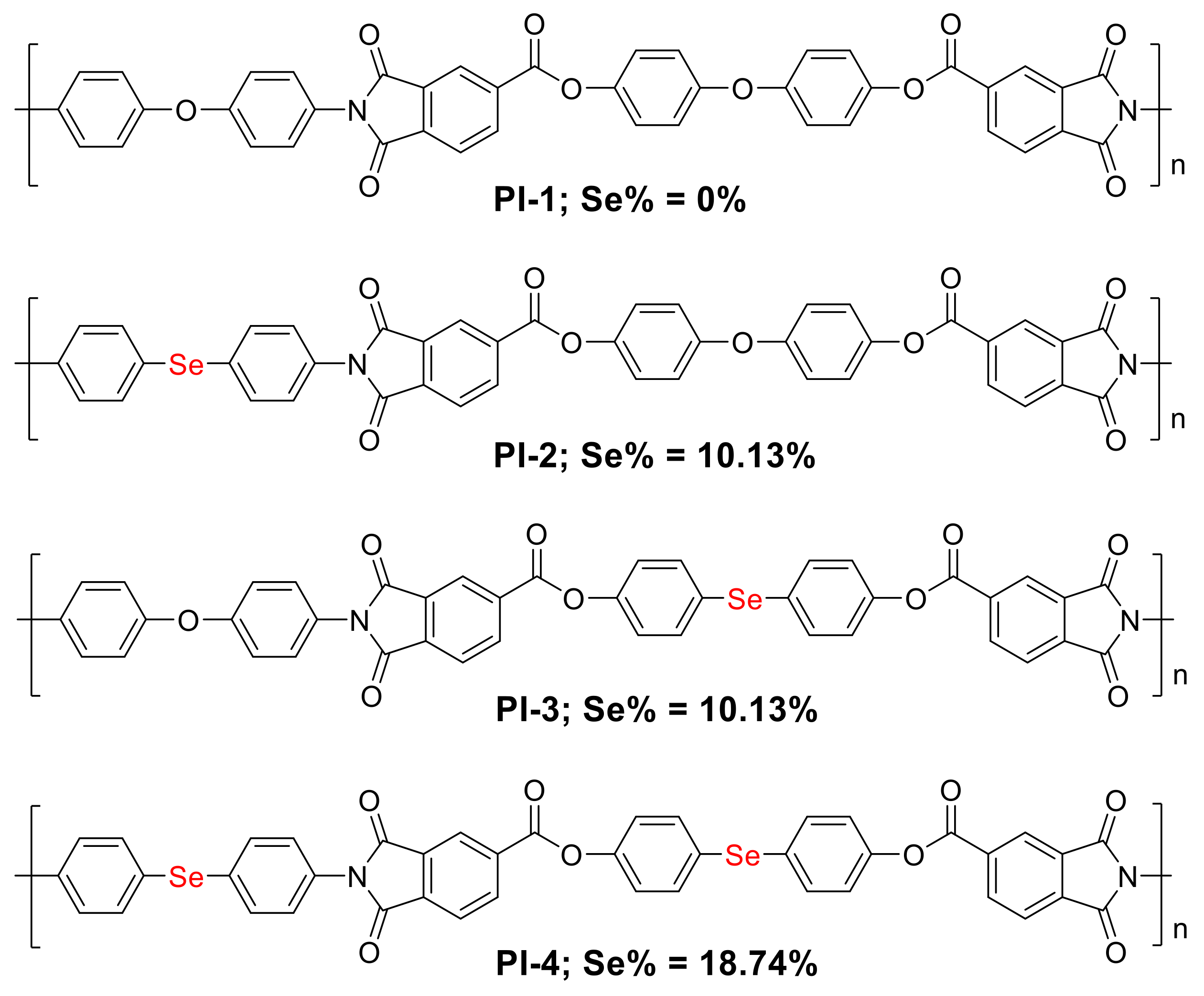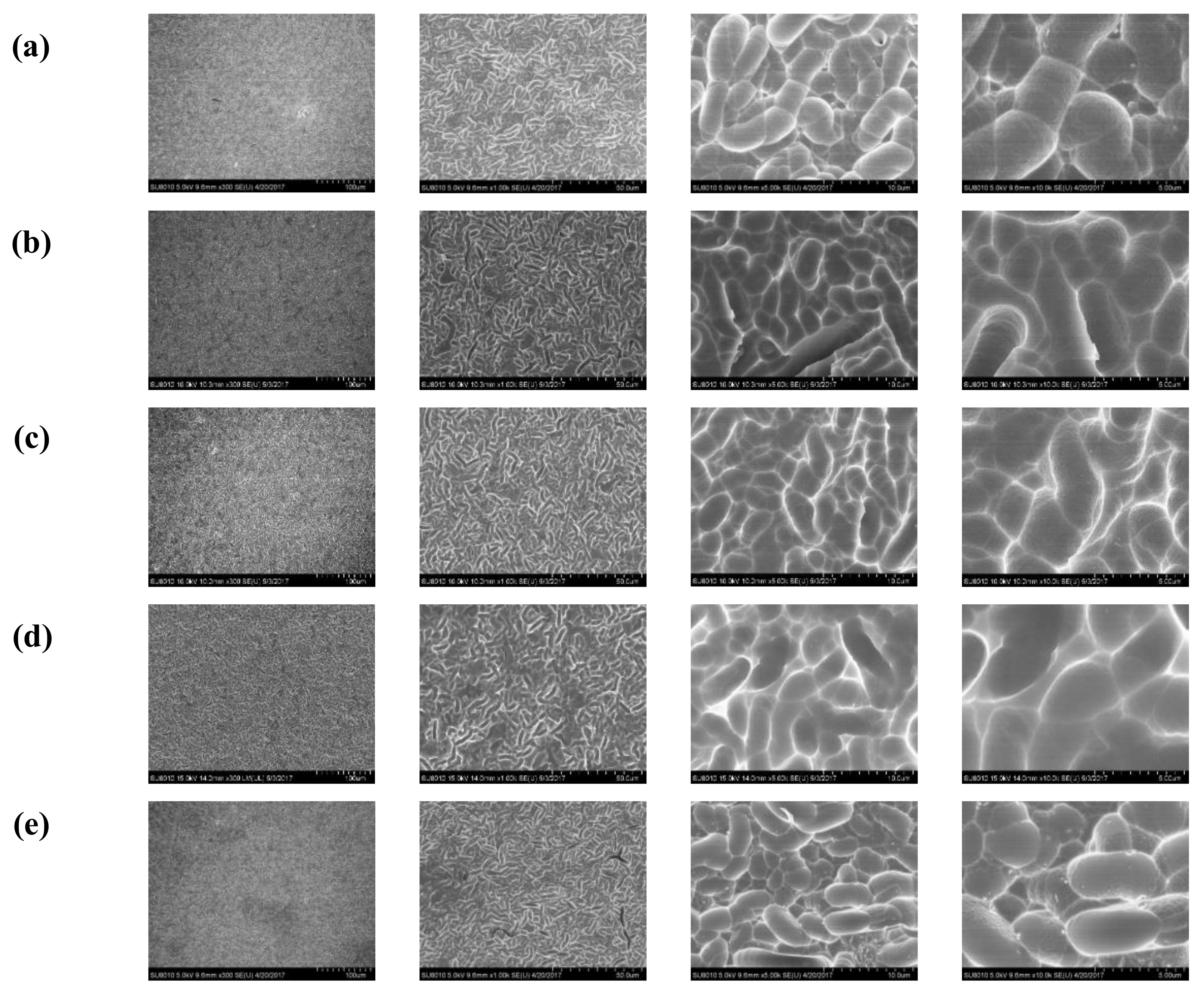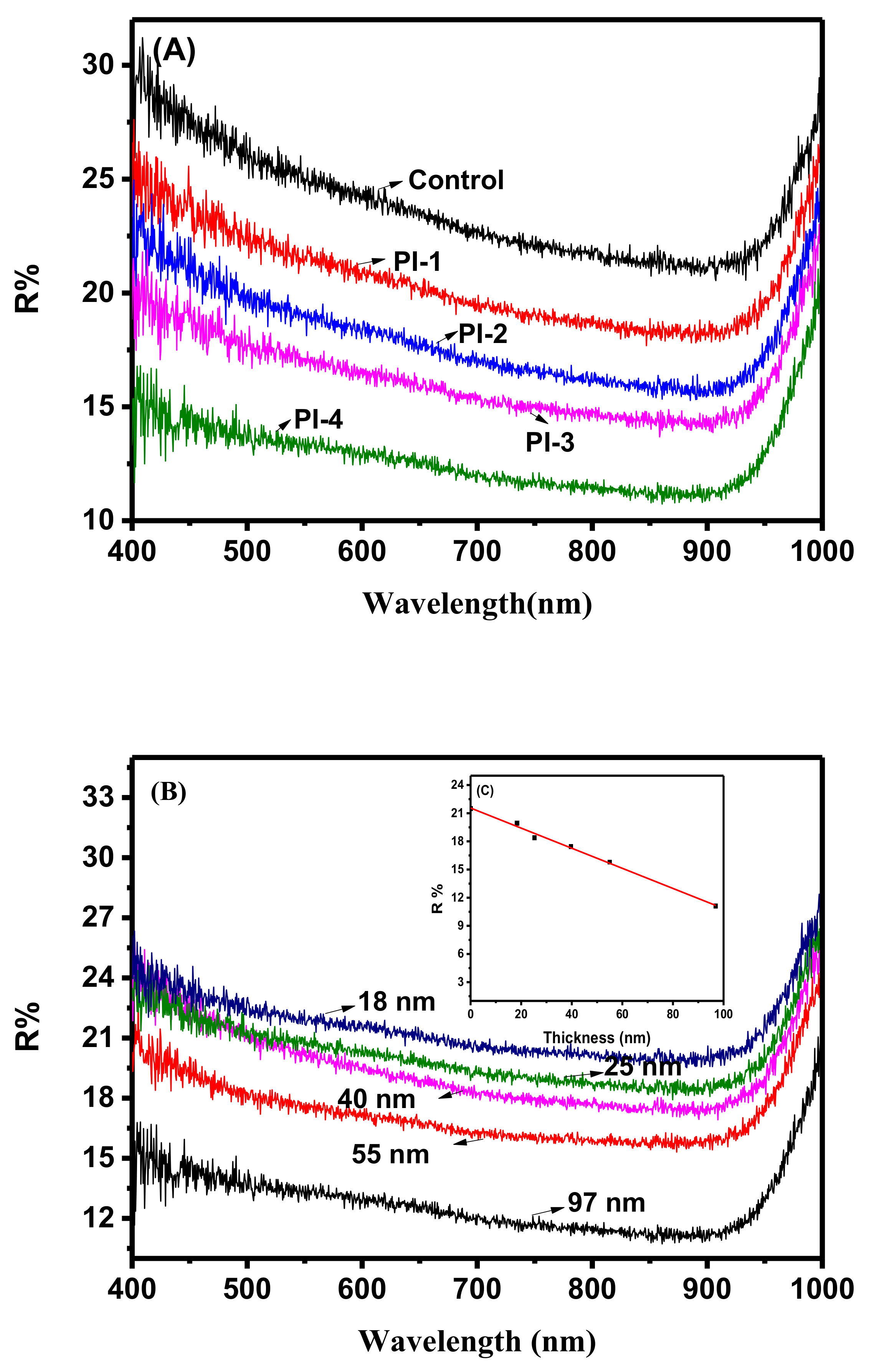Selenide-Containing Polyimides with an Ultrahigh Intrinsic Refractive Index
Abstract
:1. Introduction
2. Materials and Methods
2.1. Materials
2.2. Measurement
2.3. Monomer Synthesis
2.4. Preparation of the Polyimide Films
3. Results and Discussion
4. Conclusions
Supplementary Materials
Acknowledgments
Author Contributions
Conflicts of Interest
References
- Krogman, K.C.; Druffel, T.; Sunkara, M.K. Anti-Reflective Optical Coatings Incorporating Nanoparticles. Nanotechnology 2005, 16, 338–343. [Google Scholar] [CrossRef] [PubMed]
- Liu, J.G.; Ueda, M. High Refractive Index Polymers: Fundamental Research and Practical Applications. J. Mater. Chem. 2009, 19, 8907–8919. [Google Scholar] [CrossRef]
- Jha, G.S.; Seshadri, G.; Mohan, A.; Khandal, R.K. Development of High Refractive Index Plastics. e-Polymer 2007, 7, 1384–1408. [Google Scholar] [CrossRef]
- Mosley, D.W.; Khanarian, G.; Conner, D.M.; Thorsen, D.L.; Zhang, T.L.; Wills, M. High Refractive Index Thermally Stable Phenoxyphenyl and Phenylthiophenyl Silicones for Light-Emitting Diode Applications. J. Appl. Polym. Sci. 2014, 131, 39824–39834. [Google Scholar] [CrossRef]
- Kitamura, K.; Okada, K.; Fujita, N.; Nagasaka, Y.; Ueda, M.; Sekimoto, Y.; Kurata, Y. Fabrication Method of Double-Microlens Array Using Self-Alignment Technology. Jpn. J. Appl. Phys. 2004, 43, 5840–5844. [Google Scholar] [CrossRef]
- Nakamura, T.; Fujii, H.; Juni, N.; Tsutsumi, N. Enhanced Coupling of Light from Organic Electroluminescent Device Using Diffusive Particle Dispersed High Refractive Index Resin Substrate. Opt. Rev. 2006, 13, 104–110. [Google Scholar] [CrossRef]
- Lorentz, H.A. Ueber die Beziehung zwischen der Fortpflanzungsgeschwindigkeit des Lichtes und der Körperdichte. Ann. Phys. 1880, 245, 641–665. [Google Scholar] [CrossRef]
- Bhagat, S.D.; Chatterjee, J.; Chen, B.; Stiegman, A.E. High Refractive Index Polymers Based on Thiol–Ene Cross-Linking Using Polarizable Inorganic/Organic Monomers. Macromolecules 2012, 45, 1174–1181. [Google Scholar] [CrossRef]
- Kleine, T.S.; Nguyen, N.A.; Anderson, L.E.; Namnabat, S.; LaVilla, E.A.; Showghi, S.A.; Dirlam, P.T.; Arrington, C.B.; Manchester, M.S.; Schwiegerling, J.; et al. High Refractive Index Copolymers with Improved Thermomechanical Properties via the Inverse Vulcanization of Sulfur and 1,3,5-Triisopropenylbenzene. ACS Macro Lett. 2016, 5, 1152–1156. [Google Scholar] [CrossRef]
- Li, Z.; Liu, J.G.; Yang, S.Y. Synthesis and Characterization of Thioether and Pyridine-Bridged Aromatic Polyimides with High Refractive Indices and High Glass Transition Temperatures. High. Perform. Polym. 2010, 22, 468–482. [Google Scholar] [CrossRef]
- Griebel, J.J.; Nguyen, N.A.; Namnabat, S.; Anderson, L.E.; Glass, R.S.; Norwood, R.A.; Mackay, M.E.; Char, K.; Pyun, J. Dynamic Covalent Polymers via Inverse Vulcanization of Elemental Sulfur for Healable Infrared Optical Materials. ACS Macro Lett. 2015, 4, 862–866. [Google Scholar] [CrossRef]
- Minns, R.A.; Gaudiana, R.A. Design and Synthesis of High Refractive Index Polymers. II. J. Macromol. Sci. Part A 1992, 29, 19–30. [Google Scholar] [CrossRef]
- Olshavsky, M.A.; Allcock, H.R. Polyphosphazenes with High Refractive Indexes Indices: Synthesis, Characterization, and Optical Properties. Macromolecules 1995, 28, 6188–6197. [Google Scholar] [CrossRef]
- Olshavsky, M.A.; Allcock, H.R. Polyphosphazenes with High Refractive Indices: Optical Dispersion and Molar Refractivity. Macromolecules 1997, 30, 4179–4183. [Google Scholar] [CrossRef]
- Fushimi, T.; Allcock, H.R. Cyclotriphosphazenes with sulfur-containing side groups: Refractive index and optical dispersion. Dalton Trans. 2009, 14, 2477–2481. [Google Scholar] [CrossRef] [PubMed]
- Shobha, H.K.; Johnson, H.; Sankarapandian, M.; Kim, Y.S.; Rangarajan, P.; Baird, D.G.; McGrath, J.E. Synthesis of high refractive-index melt-stable aromatic polyphosphonates. J. Polym. Sci. Part A 2001, 39, 2904–2910. [Google Scholar] [CrossRef]
- Yan, H.H.; Chen, S.; Lu, M.; Zhu, X.; Li, Y.Q.; Wu, D.Z.; Tu, Y.F.; Zhu, X.L. Side-Chain Fullerene Polyesters: A New Class of High Refractive Index Polymers. Mater. Horiz. 2014, 1, 247–250. [Google Scholar] [CrossRef]
- Chen, S.; Chen, D.; Lu, M.; Zhang, X.; Li, H.; Zhang, X.; Yang, X.; Li, X.; Tu, Y.; Li, C.Y. Incorporating Pendent Fullerenes with High Refractive Index Backbones: A Conjunction Effect Method for High Refractive Index Polymers. Macromolecules 2015, 48, 8480–8488. [Google Scholar] [CrossRef]
- Okutsu, R.; Ando, S.; Ueda, M. Sulfur-Containing Poly(meth)acrylates with High Refractive Indices and High Abbe’s Numbers. Chem. Mater. 2008, 20, 4017–4023. [Google Scholar] [CrossRef]
- Okutsu, R.; Suzuki, Y.; Ando, S.; Ueda, M. Poly(thioether sulfone) with High Refractive Index and High Abbe’s Number. Macromolecules 2008, 41, 6165–6168. [Google Scholar] [CrossRef]
- Liu, J.G.; Nakamura, Y.; Ogura, T.; Shibasaki, Y.; Ando, S.; Ueda, M. Optically Transparent Sulfur-Containing Polyimide-TiO2 Nanocomposite Films with High Refractive Index and Negative Pattern Formation from Poly(amic acid)-TiO2 Nanocomposite Film. Chem. Mater. 2008, 20, 273–281. [Google Scholar] [CrossRef]
- Liu, J.G.; Nakamura, Y.; Shibasaki, Y.; Ando, S.; Ueda, M. High refractive Index Polyimides Derived from 2,7-bis(4-aminophenylenesulfanyl)thianthrene and Aromatic Dianhydrides. Macromolecules 2007, 40, 4614–4620. [Google Scholar] [CrossRef]
- Liu, J.G.; Nakamura, Y.; Suzuki, Y.; Shibasaki, Y.; Ando, S.; Ueda, M. Highly Refractive and Transparent Polyimides Derived from 4,4′-[m-sulfonylbis(phenylenesulfanyl)]diphthalic Anhydride and Various Sulfur-Containing Aromatic Diamines. Macromolecules 2007, 40, 7902–7909. [Google Scholar] [CrossRef]
- Liu, J.G.; Nakamura, Y.; Shibasaki, Y.; Ando, S.; Ueda, M. Synthesis and Characterization of Highly Refractive Polyimides from 4,4′-thiobis[(p-phenylenesulfanyl)aniline] and Various Aromatic Tetracarboxylic Dianhydrides. J. Polym. Sci. Part A Polym. Chem. 2007, 45, 5606–5617. [Google Scholar] [CrossRef]
- Liu, J.G.; Li, Z.; Gao, Z.; Yang, H.; Yang, S. Synthesis and Properties of Sulfur-Heterocyclic-Bridged Polyimides with High Refractive Index. Acta Polym. Sin. 2009, 1, 11–16. [Google Scholar] [CrossRef]
- Higashihara, T.; Ueda, M. Recent Progress in High Refractive Index Polymers. Macromolecules 2015, 48, 1915–1929. [Google Scholar] [CrossRef]
- Speight, J.G. Lange’s Handbook of Chemistry; McGraw-Hill: New York, NY, USA, 2005. [Google Scholar]
- You, U.H.; Fukuzaki, N.; Suzuki, Y.; Nakamura, Y.; Higashihara, T.; Ando, S.; Ueda, M. Synthesis of High-Refractive Index Polyimide Containing Selenophene Unit. J. Polym. Sci. Part A 2009, 47, 4428–4434. [Google Scholar] [CrossRef]
- Chung, W.J.; Griebel, J.J.; Kim, E.T.; Yoon, H.; Simmonds, A.G.; Ji, H.J.; Dirlam, P.T.; Glass, R.S.; Wie, J.J.; Nguyen, N.A.; et al. The Use of Elemental Sulfur as an Alternative Feedstock for Polymeric Materials. Nat. Chem. 2013, 5, 518–524. [Google Scholar] [CrossRef] [PubMed]
- Griebel, J.J.; Namnabat, S.; Kim, E.T.; Himmelhuber, R.; Moronta, D.H.; Chung, W.J.; Simmonds, A.G.; Kim, K.J.; van der Laan, J.; Nguyen, N.A.; et al. New Infrared Transmitting Material via Inverse Vulcanization of Elemental Sulfur to Prepare High Refractive Index Polymers. Adv. Mater. 2014, 26, 3014–3018. [Google Scholar] [CrossRef] [PubMed]
- Anderson, L.E.; Kleine, T.S.; Zhang, Y.Y.; Phan, D.D.; Namnabat, S.; LaVilla, E.A.; Konopka, K.M.; Diaz, L.R.; Manchester, M.S.; Schwiegerling, J.; et al. Chalcogenide Hybrid Inorganic/Organic Polymers: Ultrahigh Refractive Index Polymers for Infrared Imaging. ACS Macro Lett. 2017, 6, 500–504. [Google Scholar] [CrossRef]
- Lu, J.J.; Zhou, N.C.; Pan, X.Q.; Zhu, J.; Zhu, X.L. Branched Polystyrene with High Reflex Index Synthesized from Selenium-Mediated Polymerization. J. Polym. Sci. Part A 2014, 52, 504–510. [Google Scholar] [CrossRef]
- Jiang, H.; Pan, X.; Li, N.; Zhang, Z.; Zhu, J.; Zhu, X. Selenide-Containing High Refractive Index Polymer Material with Adjustable Refractive Index and Abbe’s Number. React. Funct. Polym. 2017, 111, 1–6. [Google Scholar] [CrossRef]
- Zhang, S.; Karra, K.; Heintz, C.; Kleckler, E.; Jin, J. Microwave-Assisted Cu2O-Catalyzed One-Pot Synthesis of Symmetrical Diaryl Selenides from Elemental Selenium. Tetrahedron Lett. 2013, 54, 4753–4755. [Google Scholar] [CrossRef]
- Li, Y.M.; Nie, C.P.; Wang, H.F.; Li, X.Y.; Verpoort, F.; Duan, C.Y. A Highly Efficient Method for the Copper-Catalyzed Selective Synthesis of Diaryl Chalcogenides from Easily Available Chalcogen Sources. Eur. J. Org. Chem. 2011, 36, 7331–7338. [Google Scholar] [CrossRef]
- Hasegawa, T.; Horie, K. Photophysics, photochemistry, and optical properties of polyimides. Prog. Polym. Sci. 2001, 26, 259–335. [Google Scholar] [CrossRef]
- Lim, H.; Cho, W.J.; Ha, C.S.; Ando, S.; Kim, Y.K.; Park, C.H.; Lee, K. Flexible Organic Electroluminescent Devices Based on Fluorine-Containing Colorless Polyimide Substrates. Adv. Mater. 2002, 14, 1275–1279. [Google Scholar] [CrossRef]
- Tapaswi, P.K.; Choi, M.C.; Jeong, K.M.; Ando, S.; Ha, C.S. Transparent Aromatic Polyimides Derived from Thiophenyl-Substituted Benzidines with High Refractive Index and Small Birefringence. Macromolecules 2015, 48, 3462–3474. [Google Scholar] [CrossRef]
- Liaw, D.J.; Wang, K.L.; Huang, Y.C.; Lee, K.R.; Lai, J.Y.; Ha, C.S. Advanced Polyimide Materials: Syntheses, Physical Properties and Applications. Prog. Polym. Sci. 2012, 37, 907–974. [Google Scholar] [CrossRef]
- Liaw, D.J.; Chang, F.C.; Leung, M.K.; Chou, M.Y.; Muellen, K. High Thermal Stability and Rigid Rod of Novel Organosoluble Polyimides and Polyamides Based on Bulky and Noncoplanar Naphthalene-Biphenyldiamine. Macromolecules 2005, 38, 4024–4029. [Google Scholar] [CrossRef]
- Liaw, D.J.; Wang, K.L.; Chang, F.C. Novel Organosoluble Poly(pyridine-imide) with Pendent Pyrene Group: Synthesis, Thermal, Optical, Electrochemical, Electrochromic, and Protonation Characterization. Macromolecules 2007, 40, 3568–3574. [Google Scholar] [CrossRef]
- Liaw, D.J.; Wang, K.L.; Chang, F.C.; Lee, K.R.; La, J.Y. Novel Poly(pyridine imide) with Pendent Naphthalene Groups: Synthesis and Thermal, optical, Electrochemical, Electrochromic, and Protonation Characterization. J. Polym. Sci. Part A 2007, 45, 2367–2374. [Google Scholar] [CrossRef]
- Wang, K.L.; Liou, W.T.; Liaw, D.J.; Huang, S.T. High Glass Transition and Thermal Stability of New Pyridine-Containing Polyimides: Effect of Protonation on Fluorescence. Polymer 2008, 49, 1538–1546. [Google Scholar] [CrossRef]




© 2018 by the authors. Licensee MDPI, Basel, Switzerland. This article is an open access article distributed under the terms and conditions of the Creative Commons Attribution (CC BY) license (http://creativecommons.org/licenses/by/4.0/).
Share and Cite
Li, Q.; Zhang, J.; Pan, X.; Zhang, Z.; Zhu, J.; Zhu, X. Selenide-Containing Polyimides with an Ultrahigh Intrinsic Refractive Index. Polymers 2018, 10, 417. https://doi.org/10.3390/polym10040417
Li Q, Zhang J, Pan X, Zhang Z, Zhu J, Zhu X. Selenide-Containing Polyimides with an Ultrahigh Intrinsic Refractive Index. Polymers. 2018; 10(4):417. https://doi.org/10.3390/polym10040417
Chicago/Turabian StyleLi, Qilong, Jiandong Zhang, Xiangqiang Pan, Zhengbiao Zhang, Jian Zhu, and Xiulin Zhu. 2018. "Selenide-Containing Polyimides with an Ultrahigh Intrinsic Refractive Index" Polymers 10, no. 4: 417. https://doi.org/10.3390/polym10040417






